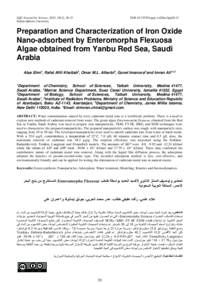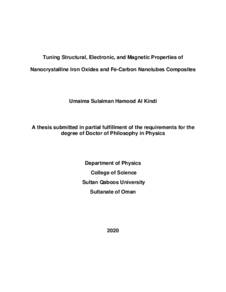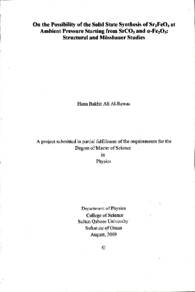Document
Preparation and characterization of iron oxide nano-adsorbent by enteromorpha flexuosa algae obtained from Yanbu Red Sea, Saudi Arabia.
Identifier
DOI: https://doi.org/10.53539/squjs.vol28iss2pp28-43
Source
Sultan Qaboos University Journal for Science. v. 28, no. 2, p. 28-43.
Contributors
Khattab, Rafat Afifi., Author
Al-Harbi, Omar M. L., Author
Imanova, Gunel., Author
Ali, Imran., Author
Other titles
.المستخرج من ينبع البحر الأحمر، المملكة العربية السعودية Enteromorpha Flexuosa تحضير وتوصيف الممتز النانوي لأكسيد الحديد بواسطة طحلب
Country
Oman.
City
Muscat.
Publisher
College of Science, Sultan Qaboos University.
Gregorian
2023-11-21
Language
English
Subject
English abstract
Water contamination caused by toxic cadmium metal ions is a worldwide problem. There is a need to explore new methods of cadmium removal from water. The green algae Enteromorpha flexuosa, obtained from the Red Sea in Yanbu, Saudi Arabia, was used to prepare iron nanoparticles. TEM, FT-IR, XRD, and SEM techniques were used to characterize the prepared nanoparticles. The prepared nanoparticle's surface was rough, with nanoparticle sizes ranging from 10 to 50 nm. The developed nanoparticles were used to adsorb cadmium ions from water in batch mode. With a 25.0 µg/L concentration, a temperature of 25˚C, 7.0 pH, 60 minutes contact time and 0.5 g/L dose, the maximum removal of cadmium was 48.2 µg/g. The sorption efficiency was measured using the Dubinin-Radushkevich, Temkin, Langmuir and Freundlich models. The amounts of ΔG° were -8.0, -9.93 and -12.24 kJ/mol while the values of ΔS° and ΔH° were -30.96 x 10-3 kJ/mol and 37.79 x 10-2 kJ/mol. These data confirmed the endothermic nature of cadmium metal ions removal. Along with the liquid film diffusion process, the adsorption adopted the kinetics of pseudo-second-order type. The recorded adsorption method is fast, cost-effective, and environmentally friendly and can be applied for testing the elimination of cadmium metal ions in natural waters.
ISSN
2414-536X
Arabic abstract
يعد تلوث المياه الناجم عن أيونات معدن الكادميوم السامة مشكلة عالمية. هناك حاجة لاستكشاف طرق جديدة لإزالة الكادميوم من الماء. تم استخدام الطحالب الخضراء Enteromorpha flexuosa، التي تم الحصول عليها من البحر الأحمر في ينبع بالمملكة العربية السعودية، لتحضير جزيئات الحديد النانوية. تم استخدام تقنيات TEM، FT-IR، XRD، وSEM لتوصيف الجسيمات النانوية المحضرة. كان سطح الجسيمات النانوية المحضرة خشنًا، وتتراوح أحجام الجسيمات النانوية من 10 إلى 50 نانومتر. تم استخدام الجسيمات النانوية المطورة لامتصاص أيونات الكادميوم من الماء في وضع الدفعة. مع تركيز 25.0 ميكروغرام/لتر، ودرجة حرارة 25 درجة مئوية، و7.0 درجة حموضة، ووقت تلامس 60 دقيقة وجرعة 0.5 غرام/لتر، كان الحد الأقصى لإزالة الكادميوم 48.2 ميكروغرام/غرام. تم قياس كفاءة الامتصاص باستخدام نماذج Dubinin-Radushkevich وTemkin وLangmuir وFreundlich. كانت كميات ΔG° -8.0، -9.93 و-12.24 كيلو جول/مول بينما كانت قيم ΔS° وΔH° -30.96 × 10-3 كيلو جول/مول و37.79 × 10-2 كيلو جول/مول. أكدت هذه البيانات الطبيعة الماصة للحرارة لإزالة أيونات معدن الكادميوم. جنبا إلى جنب مع عملية نشر الفيلم السائل، اعتمدت عملية الامتزاز حركية النوع من الدرجة الثانية الزائفة. طريقة الامتزاز المسجلة سريعة وفعالة من حيث التكلفة وصديقة للبيئة ويمكن تطبيقها لاختبار التخلص من أيونات معدن الكادميوم في المياه الطبيعية.
Category
Journal articles



